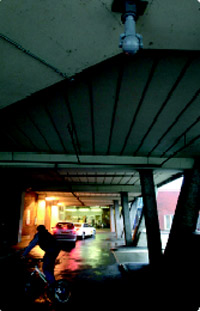
As part of a wider regeneration project to encourage investment in the town, Medway Council decided to make substantial changes to the road network in Chatham. Its one-way ring road system was identified as a restriction affecting inward investment in the retail centre of the town. The major road works involved upgrading the town's ring road system route to two-way traffic.
Following a review it identified a gap in the CCTV coverage that it needed to fill. However, the new areas needing to be covered were difficult to reach with Medway's existing CCTV system.
Wireless CCTV for quick implementation
Ian Wilson is Head of Capital Projects at Medway Council. He explains the situation, "We already had town centre and car park CCTV which covered most of the network, but to complete our coverage we had a requirement for two new cameras. None of the existing CCTV transmission options that we were using were obvious solutions.
"The two new locations were tucked up very close to a shopping centre - so close that they were almost under it. The distance was too great for a hard-wire, there was no line of sight available to the microwave receiver at the two locations where we wanted to put our new cameras and there was no obvious point of presence for our fibre network without a lot of trenching." And trenching was the one thing that Ian and his team were trying to avoid. "We didn't want a lot of additional work being carried out along the road we were already working on," he says. "The need to run trenching and lay ducts for fibre transmission would have delayed or interfered with the two way road work - and we had a very tight time schedule. We needed to get the CCTV operational in just a couple of months."
Medway discussed the problem with its CCTV contractor Land Services and they suggested using wireless technology for the image transmission. "We had a look at wireless and it seemed to be the answer we were looking for," says Ian. Although cost was obviously an important consideration, it was not the primary factor in Medway's decision to choose wireless. "We chose wireless because of the lack of disruption that the installation would cause, and because it was relatively quick to deploy," explains Ian. "You still have to provide the camera with a new electrical supply - but even so that was a quicker and more practical solution than cabling." Having decided to use wireless transmission, Medway looked at a variety of wireless solutions. And after consideration it chose BT Redcare's wireless technology. "We went with BT Redcare partly because it was already providing the fibre transmission point of presence that the new cameras would link to, and partly because there were significant time pressures on the project - a short installation deadline that we had to hit," says Ian. "It was a team approach. Everybody got together. Ourselves, our CCTV contractors Land Services, BT Redcare for the transmission and EDF for power."
The existing fibre at that point had sufficient extra bandwidth to carry the real-time monitoring signals from the two additional cameras back to the control centre. The BT Redcare solution uses directional Wi-Fi (802.11a) antennae to bring the CCTV camera data across the distances - 100 metres and 200 metres, respectively - from the two new cameras to the BT Redcare analogue fibre node. The images are transmitted as AES encrypted secure digital MPEG-4 data. The digital wireless signal is converted at the fibre node to analogue for onward transmission via Medway's existing analogue CCTV transmission network. The solution takes advantage of spare analogue capacity on the existing fibre network to transmit the signals. Images are transmitted across the wireless link at the same frame rate and image resolution as other cameras on the Medway system that are connected to the monitoring centre directly by fibre optic cable.
In and working
The project was given the go-ahead in spring 2006 and went live that summer. Since then, says Ian, there have been no problems. "The wireless system is working fine," he says. "BT Redcare wanted the business and, during the installation, the BT Redcare team were very helpful. As far as I am concerned there is no discernable difference in the quality of the pictures we are getting back from the wireless cameras compared with our other cameras." As a result, BT's wireless extensions technology is now established as one of the suite of solutions that Medway Council will consider for any future CCTV network extensions. "We'd certainly consider using wireless in the future - depending on the particular problem," says Ian. "Particularly if time was a factor or if it was very important that we didn't dig something up. We might consider wireless for use in conservation areas or ancient monuments, for example," he adds.
A practical solution
Ian explains why Medway Council chose BT Redcare. "We chose the BT Redcare wireless transmission technology because it offered a practical and less disruptive solution than cabling. By linking the wireless transmission to the nearest point on our existing BT Redcare fibre we were able to quickly extend our coverage and bring back high quality images from difficult-to-reach locations. Given the tight timescales, we wanted a supplier who was familiar with our existing CCTV infrastructure. Availability and deliverability of the solution is key - this helps our project risk management. BT Redcare meets these requirements."